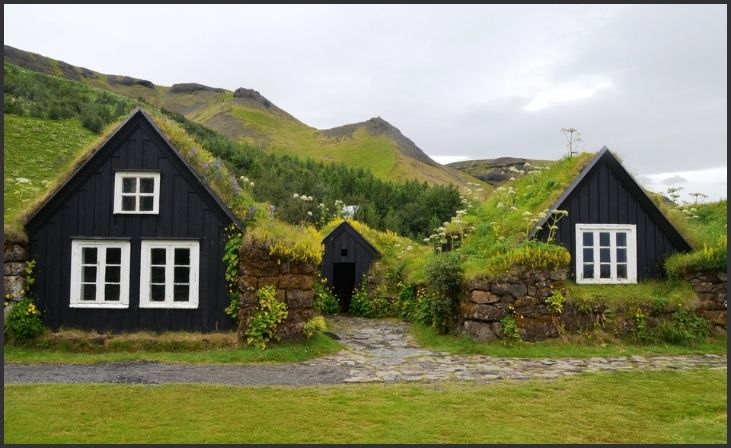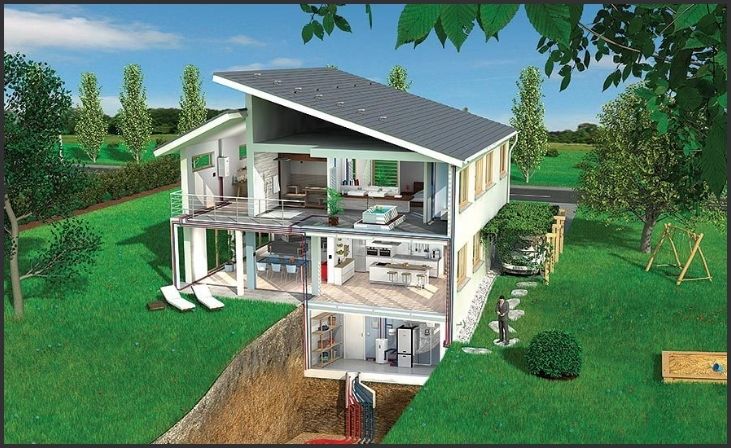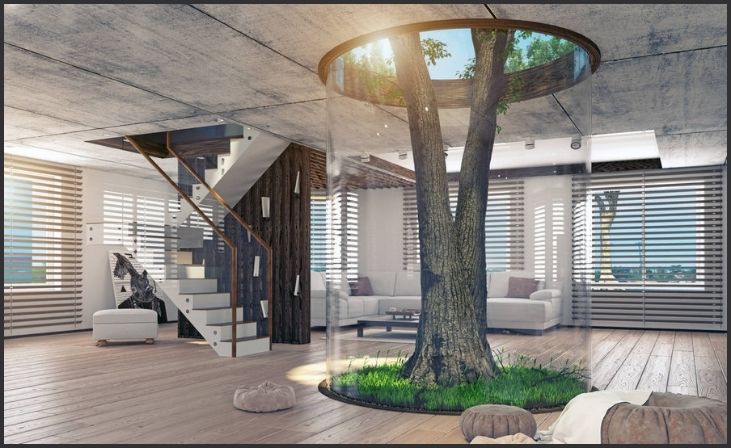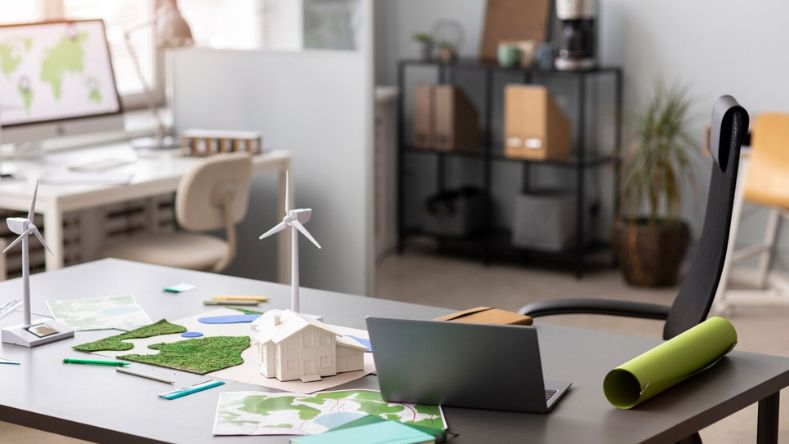Modern sustainable home design – In today’s rapidly evolving world, the concept of sustainable living and eco-conscious design has transcended mere buzzwords to become a profound way of life. The urgent need for sustainable housing options has surged, paralleled by a growing demand for innovative design trends harmonizing with our unwavering commitment to safeguarding the environment.
Within this article’s pages, we explore the top 9 modern sustainable home design trends that stand as the vanguards of future housing. From the architectural wonders of eco-friendly construction to the ingenious solutions of energy efficiency, these trends captivate with their aesthetic charm and bear the noble responsibility of environmental stewardship.
This dynamic transformation in our approach to creating living spaces is more than a response to a global call for sustainability. It’s a conscious shift towards a greener, healthier, and more responsible way of living, and in this journey, we are guided by these 9 remarkable trends.
The Top 9 Modern Sustainable Home Design Trends
Green Roofs: Bringing Nature to Your Home

The concept of green roofs has blossomed into a beloved eco-friendly architectural trend. These living roofs are adorned with an array of lush plants, creating a flourishing oasis atop your home. But it’s not just about aesthetics; these green roofs serve a vital purpose. They provide natural insulation, acting as a protective shield against extreme temperatures. By doing so, they reduce energy consumption, leading to lower heating and cooling costs. Moreover, green roofs support biodiversity, offering a haven for birds, insects, and other wildlife, transforming your home into a micro-ecosystem.
Also Read:- Eco-Friendly Choices
Solar Panels: Using The Sun’s Energy
Solar panels have set a new standard in energy consumption within homes. These sleek, photovoltaic marvels are adept at capturing the sun’s radiant energy and converting it into electricity. As a homeowner, this translates to substantial savings on your electricity bills. Beyond the economic benefits, the use of solar panels significantly minimizes the carbon footprint, making your home an eco-friendly powerhouse. It was another one of the most popular modern sustainable home design.
Passive House Design: Extreme Energy Efficiency
Passive house design is a revolutionary approach to home construction that places energy efficiency at its core. It’s all about creating an airtight envelope for your home, incorporating superior insulation, and implementing energy recovery ventilation systems. The result? Minimal heating and cooling requirements, leading to drastically reduced energy consumption and, consequently, lower utility bills.
Smart Home Technology: Energy Management
Imagine having the power to manage your home’s energy consumption with a few taps on your smartphone. Smart home technology makes it a reality. With intelligent devices and systems, homeowners can seamlessly control lighting, heating, and other energy-consuming aspects of their homes. This not only reduces waste but also contributes to significant cost savings.
Natural and Recycled Materials: Sustainable Building
The use of natural and recycled materials in construction has become a cornerstone of sustainable building practices. These materials, including reclaimed wood, bamboo, and recycled steel, not only reduce the environmental impact but also add a unique, rustic charm to homes. This trend promotes responsible, eco-conscious choices when it comes to building your dream home.
Water Conservation: Sustainable Landscaping
Sustainable home design extends beyond the structure itself to the surrounding landscape. Water-efficient landscaping practices are crucial in conserving this precious resource. Techniques like xeriscaping, rainwater harvesting, and the use of drought-tolerant plants minimize water consumption while promoting eco-friendly irrigation methods. Keep scrolling through to know more modern sustainable home design.
Also Read:- Benefits of Green Technology
Energy-Efficient Appliances: Minimizing Power Usage
Modern homes are now equipped with a wide array of energy-efficient appliances. These appliances are designed to optimize power usage, resulting in not only lower electricity bills but also a significant reduction in greenhouse gas emissions. They are a testament to the integration of technology with sustainable living.
Geothermal Heating and Cooling: Harnessing Earth’s Energy

Geothermal systems harness the Earth’s stable temperature to provide efficient heating and cooling for homes. By tapping into this natural resource, homeowners enjoy consistent indoor comfort while reducing energy costs and minimizing their environmental footprint.
Green Insulation: Reducing Heat Loss
Eco-friendly insulation materials like recycled denim and cellulose play a critical role in reducing heat loss in homes. By preventing heat from escaping in the winter and keeping interiors cool in the summer, these materials contribute to both energy efficiency and comfort. Continue reading to know more about the modern sustainable home design.
Fundamental Principles To Consider While Choosing Eco-Friendly Interior Design
1. Use Sustainable Materials:
Opting for sustainable materials is a fundamental step in eco-friendly interior design. Consider using reclaimed wood, which minimizes deforestation and adds a rustic and unique charm to your space. Bamboo is another excellent choice as it grows rapidly, making it a renewable resource. Cork is both sustainable and versatile, perfect for flooring or wall coverings. Recycled metal and glass can be repurposed for various decor elements, reducing the demand for new resources.
2. Energy-Efficient Lighting:
Incorporating energy-efficient lighting is crucial for reducing your electricity consumption. LED lighting, in particular, is highly energy-efficient and durable, resulting in long-term cost savings. To maximize natural light, strategically position windows and skylights to reduce the need for artificial lighting during the day. This not only saves energy but also creates a bright and inviting atmosphere.
3. Choose Low-VOC Paints:
Low-VOC or VOC-free paints are essential for maintaining good indoor air quality and minimizing environmental harm. Volatile Organic Compounds (VOCs) found in traditional paints can release harmful chemicals into the air. Opting for low-VOC or VOC-free paints for your walls and furniture safeguards your health and contributes to a greener living space.
4. Upcycle and Repurpose:
Breathing new life into old furniture and decor items through upcycling and repurposing is an excellent way to reduce waste and infuse character into your interior. Whether it’s refurbishing a vintage piece of furniture, turning pallets into a coffee table, or repurposing old doors as room dividers, these creative projects can give your space a unique and personalized touch.
5. Indoor Plants:
Plants inside not only make the space look better, but they also clean the air. They act as natural air purifiers, removing toxins and enhancing the overall ambiance of your interior. Incorporate a variety of houseplants, such as snake plants, pothos, and peace lilies, to bring nature indoors and create a healthier living environment.
6. Energy-Efficient Appliances:

When selecting appliances for your home, prioritize Energy Star-rated products. These appliances are designed to consume less energy, reducing your carbon footprint and lowering your utility bills. From refrigerators to washing machines, energy-efficient appliances are a wise investment in a sustainable and cost-effective home.
Also Read:- How To Make Sustainable Food Choices
7. Proper Insulation:
Good insulation is a critical component of an eco-friendly interior. Properly insulated walls, ceilings, and windows help maintain a consistent indoor temperature. This reduces the need for excessive heating or cooling, saving energy and reducing greenhouse gas emissions. High-quality insulation not only promotes energy efficiency but also enhances your overall comfort.
Conclusion
The top 9 modern sustainable home design trends enhance the visual appeal of your living space and play a crucial role in preserving the environment. By embracing these trends, homeowners can enjoy the benefits of Sustainable living, which include reduced energy bills and a smaller carbon footprint.
These design trends aren’t just about how things look; they’re also a choice toward a more eco-friendly and long-lasting way of life. We are all working toward a more environmentally friendly future, and these trends help us build homes that work well with nature. This will make the world greener, healthier, and more environmentally friendly for future generations.
FAQs
Sustainable home design trends focus on creating living spaces that are environmentally responsible, using eco-friendly materials and energy-efficient systems.
You can make your home more sustainable by incorporating green roofs, solar panels, energy-efficient appliances, and using recycled materials in construction.
